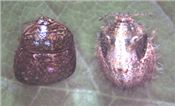|
Kudzu Bug Continues Its Trek Across The State

Kudzu bug.
Photo by Jeff Davis
BATON ROUGE, LA.
The kudzu bug, an invasive pest from Asia, continues its trek into Louisiana. LSU AgCenter scientists have been monitoring the movement of the insect since it was discovered in 2014 in Louisiana after moving in from Mississippi.
Pointe Coupee, Lafayette and Webster are the latest parishes to be added to the list, according to LSU AgCenter entomologist Jeff Davis.
“In 2014, the bug was first seen in the following parishes: Concordia, West Carroll, Tangipahoa, Washington, West Feliciana and East Baton Rouge,” Davis said.
Before being found in East Baton Rouge Parish, the insect was not known to reproduce in soybeans, Davis said.
“We know that it overwinters as adults. Then they go on to kudzu because it’s about the first thing to green up in the spring,” Davis said. “It then moves on to soybeans in the warmer months and then back to kudzu in fall.”
This pest has been on a westward course across the U.S. since it was first spotted in Georgia in 2009.
Davis said the first sighting of the pest was near Atlanta’s Hartfield International Airport, which leads him to believe the pest entered this country on shipping containers or luggage.
It is believed that humans are the main transport vehicle for this invasive species, either on vehicles or on clothing.
“The pest is known for catching rides, even though it can fly,” David said. “It is attracted to white objects, so white or other light-colored vehicles would probably be their selection for hitchhiking.”
The name of the insect may be a bit deceiving because it is also known to feed on the stems of soybean plants and other legumes.
This is not a pest that farmers will want around their fields because it is capable of reducing yields by about 20 percent, he said. “That’s compared to up to an 80 percent reduction in yields by stink bugs.”
Kudzu bugs are not pod-feeders like a stink bug. Instead, they feed on the stem and leaves of plants.
On the positive side, the kudzu bug is not hard to control. The same chemicals used to control stink bugs will control the kudzu bug, Davis said.
A negative is kudzu bugs are about the same size as ladybeetles and are known to overwinter in homes as well as in tree bark and under leaves.
Because using powerful insecticides in the home is not an option, Davis recommends using a shop vacuum to collect the insects, then place them in a plastic bag and put it in the freezer for a few weeks to kill them.
It’s not known what the coldest temperatures are that this pest can survive in, but the kudzu plant is known to be in areas as far north as Ontario, Canada.
“In areas with really cold winters last year like Georgia, North Carolina and South Carolina, they aren’t having much of a problem with the pest,” Davis said. “We, on the other hand, have had relatively mild winters since 2010.”
The kudzu bug is now known to be in Missouri, Kentucky, Tennessee, Arkansas, Florida, Virginia, North and South Carolina, Alabama, Mississippi, Louisiana and Georgia. ∆
|
|